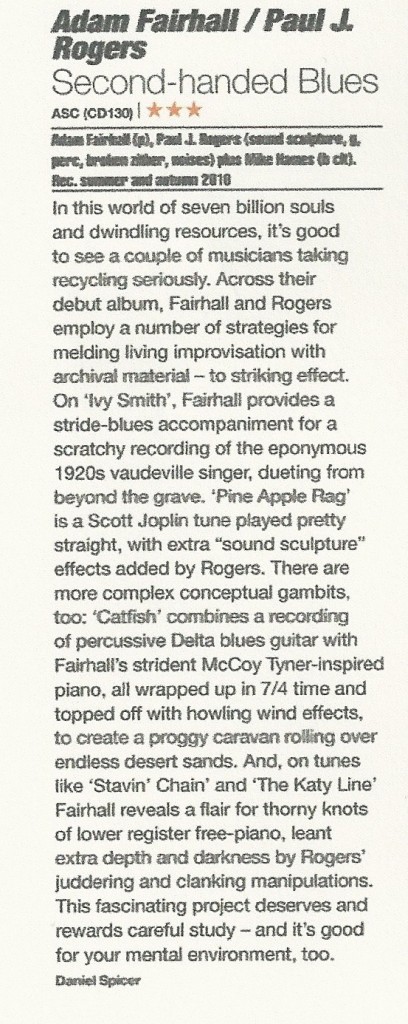Jazzwise Review, December 2011:
Review from N.W.Jazzworks, summer 2011:
Adam Fairhall & Paul J Rodgers
Second-Handed Blues
While on the whole jazz is considered a forward thinking art form, with its generational breaks with the past and innovative shifts in style, it’s also true to say that many of even the most avant-garde players have looked back for inspiration. Think Thelonious Monk adapting J P Johnson’s stride technique and adding bebop, or Sun Ra borrowing from Fletcher Henderson’s big band arrangements to create some of the most ‘out there’ music with his Arkestra. There have always been musicians on the fringes looking over their shoulder in order to move forward, and it is within this fine tradition that Cheshire based pianist Adam Fairhall has firmly placed himself.
Jumping from Scott Joplin, to McCoy Tyner, to Champion Jack Dupree, Fairhall’s style on Second-Handed Blues is hard to pin down at first, but as the album takes form it becomes clear that this is a player with a very good idea of what he wants. This is not pastiche, or irony, this is an album of compositions that utilises the patchwork jazz history cohesively, combining elements of several traditions to produce a unique and innovative sound. In Paul J Rogers, Fairhall has obviously found a collaborator on the same wave length. His use of contemporary production techniques and archive material adds a depth to this record, moving it from a perfectly interesting solo piano outing, to something weirdly beguiling. The album is nicely book-end by its opener Ivy Smith, on which Fairhall is accompanied by an unknown vaudeville blues singer (her Bessie Smith-like vocal hisses out of the gramophone while the melancholic walking blues staggers along drenching in bourbon and regret), and its closer Saw Dog Man, a Jimmy Yancey style Boogie Woogie number that uses a sample of some kind of Mississippi preacher’s drawl that covers the track with a fine layer of vintage dust. The rest of the album is peppered with some very dark Cecil Taylor influenced free improvisation, and it is on these tracks that Rodgers’ production style particularly shines through. On The Katy Line, and The Okeehumkee on the Oklawaha the listener is bombarded with a dense sound-world of throbbing loops, toys instruments and broken objects used for their musical potential.
While the likes of The Bad Plus and Brad Mehldau are looking towards the Top 40 for inspiration these days, on Second-Handed Blues Fairhall and Rodgers have dug deep into the archives of jazz to find their own fresh sound. In a way Fairhall is the archaeologist on this project and Rodgers his curator; one brushes away the layers of musical sediment to uncover long forgotten artefacts, while the other carefully reorganises them for re-examination and reinterpretation. The result is a thought-provoking display, rich with ideas.
Chris Ackerley
Review from International Piano Magazine, autumn 2011:
Adam Fairhall/Paul J. Rogers: Second-Handed Blues
Adam Fairhall (pf), Paul J Rogers (electronics, sound sculpture), Mike Hames (bass clarinet)
ASC 130 CD, 44 minutes
The debut album by this duo can be seen as a kind of archaeological exploration of blues piano and its place in the history of recorded sound. The “compositions” credit could say something like “Jazz and blues compositions and improvisations by Adam Fairhall, with soundscapes and Americana recordings synthesised by Paul J Rogers”. Each piece focusses on a distinct set of ideas or elements, pianistic and recorded. The acousmatic backdrop of “Ivy Smith” is that blues singer’s 1920s vocal “Sad and Blue”, with Fairhall’s piano solo in more updated blues style, that is, post-bebop, in which Charlie Parker synthesised the blues with the harmonic influence of Tin Pan Alley standard songs. The darkly powerful “Catfish” features Robert Petway’s delta blues guitar from his “Catfish Blues”. “Saw Dog Man” is a pleasing synthesis of traditional and contemporary blues by Fairhall, over a treatment of “Old Rattler” by Mose Platt/James Baker and “Hammer Ring” by Jesse Bradley. Some of the treatments are fairly radical, conceptual in fact – on the plangent “Piney Woods Motel”, for instance, blues by Margaret Johnson and Henry Truvillion are the sources for the sound sculpture, but no longer recognisable as voices. I’m less sure about the treatment of Bukka White’s monologue “Mixed Water” on “Ballad of a Backslider”, where varying speeds and spatial disintegration distract from rather than enhance Fairhall’s haunting bluesy minimalism. The pianist’s playing covers a multitude of bases – ragtime, boogie, bop and free jazz – while Paul J Rogers’ soundscapes and production concepts inhabit, if anything, an even broader stylistic range. A haunting and intriguing set of performances.
Andy Hamilton


